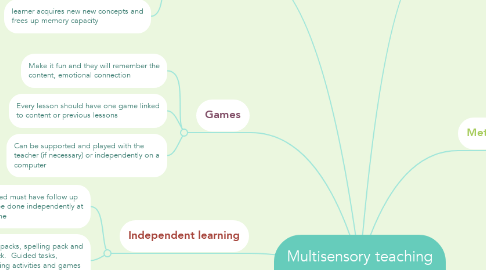Multisensory teaching strategies
by Mary-Ann Clark

1. Routines
1.1. for spelling, writing and memory work (direct teaching)
1.2. consistent approach establishes security
1.3. familiarity +consistency help automaticity
1.4. learner acquires new new concepts and frees up memory capacity
2. Independent learning
2.1. lessons covered must have follow up activities, to be done independently at school or home
2.2. includes reading packs, spelling pack and concept card pack. Guided tasks, worksheets, reading activities and games (including ICT games and software)
3. Games
3.1. Make it fun and they will remember the content, emotional connection
3.2. Every lesson should have one game linked to content or previous lessons
3.3. Can be supported and played with the teacher (if necessary) or independently on a computer
4. Revision/Review
4.1. Most important of cumulative programme, rehearse and practise content previously taught
4.2. Introduce new teaching point once previous knowledge is embedded
4.3. Build on older teaching points, extend knowledge
4.4. Revision aids memory, overlearning, automaticity and understanding
4.5. End of each lesson, learner reviews new learning, prompted by teachers questions and an activity like Stimulus Response Routine
5. Guided discovery
5.1. used when introducing a new teaching point
5.2. e.g. phonemes, concepts, spelling rules or punctuation
5.3. learners will recall more efficiently when they discover for themselves.
5.4. approach is guided and structured by teacher (support learners discovery)
6. Metacognition
6.1. Key feature of programme
6.2. develop metacognitive awareness (understanding of how they learn)
6.3. enabling learners to take control of learning, build confidence and self-esteem
6.4. Gives insights into learning, apply to other intervention sessions.
6.5. Help them develop a metalanguage (vocabulary to help them explain what they are thinking and doing in their learning)
6.6. Offer different ways of learning, choose which one works in different contexts. Encourge them to articulate how they learned a teaching point
7. Verbalisation/Vocalisation
7.1. Very important for the learner to vocalise spelling, dictation routines, writing and reading activities
7.2. establishes verbal memory
7.3. makes multisensory links
7.4. this 'habit' help with subvocalising in class and in homework activities


